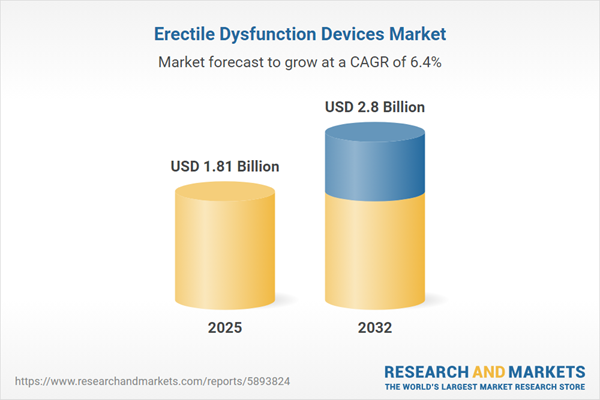Speak directly to the analyst to clarify any post sales queries you may have.
The erectile dysfunction devices market is undergoing rapid transformation, shaped by technological innovation, evolving patient needs, and shifting regulatory environments. This specialized report provides a comprehensive view of key trends, product advancements, and competitive strategies crucial for senior decision-makers navigating this critical healthcare sector.
Market Snapshot: Erectile Dysfunction Devices Market Overview
The Erectile Dysfunction Devices Market grew from USD 1.71 billion in 2024 to USD 1.81 billion in 2025. It is expected to continue at a CAGR of 6.35%, reaching USD 2.80 billion by 2032. Rising healthcare demand, demographic shifts, and the integration of digital health solutions drive this sustained expansion. Market growth is further reinforced by ongoing medical innovation and partnerships among leading manufacturers, healthcare providers, and academic institutions. These factors collectively influence strategic planning and investment in this dynamic industry.
Scope & Segmentation Analysis
- Product Types: Penile implants, including inflatable and semi-rigid varieties; supportive devices such as clamping and ring constriction devices; therapeutic devices encompassing low-intensity pulsed ultrasound and shockwave therapy devices; vacuum constriction devices.
- Indications: Mixed erectile dysfunction driven by aging-related or multiple causes; primary erectile dysfunction with neurological or vascular origins; secondary erectile dysfunction stemming from hormonal or psychogenic factors.
- Age Groups: 18-40 years; 41-60 years; 61 years and above.
- Material Types: Elastomeric, metallic (including stainless steel and titanium), polyurethane, silicone.
- Mechanisms of Action: Hydraulic action devices, mechanical action devices.
- Power Sources: Battery-powered devices, manual solutions.
- End-User Settings: Home healthcare, hospitals, specialty clinics.
- Distribution Channels: Online platforms, retail pharmacies, specialist retailers (medical device and surgical supply stores).
- Geographical Coverage: Americas (North and Latin America), Europe, Middle East & Africa, Asia-Pacific regions with detailed country-level insights.
- Company Analysis: Profiling of major and emerging manufacturers, including Boston Scientific Corporation, Coloplast A/S, Advin Health Care, and Rigicon, Inc., among others.
Erectile Dysfunction Devices Market: Key Takeaways
- Significant advancements in implantable systems and non-invasive therapies are driving accessibility and personalizing patient care, while also meeting heightened regulatory standards.
- Integration of digital health, such as telemedicine and real-time monitoring, enhances device usability and supports iterative product development based on patient behavior and clinical outcomes.
- Increasing collaboration across manufacturers, healthcare providers, and research institutes accelerates innovation pipelines and validates efficacy with robust clinical evidence.
- Shifts in demographic profiles—including a growing aging population and rising comorbidity rates—magnify demand for solutions emphasizing comfort, safety, and long-term durability.
- Material choices, from biocompatible polymers to advanced metals, influence device longevity, comfort, and patient acceptance in both mature and emerging markets.
Tariff Impact: Navigating 2025 U.S. Supply Chain Adjustments
- The 2025 introduction of new tariffs on imported erectile dysfunction device components, such as metallic implants and electronic modules, increases production costs, pressuring manufacturers to optimize global sourcing strategies.
- Efforts to regionalize manufacturing, strengthen partnerships with local contract manufacturers, and adjust inventory management are emerging to maintain price competitiveness and availability.
- Distributors and healthcare providers may see pricing shifts and are responding with bundled service models and strategic collaborations to preserve access and value.
Methodology & Data Sources
This report leverages a mixed-method approach, integrating secondary data from scientific journals, regulatory filings, and industry publications with targeted primary interviews from thought leaders, urologists, and device engineers. Quantitative and qualitative data are triangulated to ensure credible market segmentation and actionable insights for senior executives.
Why This Report Matters
- Equips C-suite and strategy leaders with actionable intelligence on innovation trends and evolving care models in the erectile dysfunction devices market.
- Supports procurement and business development with detailed, company-level competitive analysis across all key global regions.
- Guides R&D and regulatory teams through clear segmentation insights and an understanding of region-specific compliance and reimbursement landscapes.
Conclusion
The erectile dysfunction devices market is evolving due to medical device innovation, digital integration, and shifting demographic trends. Informed strategic action and cross-sector collaboration remain essential for capturing emerging opportunities in this dynamic field.
Additional Product Information:
- Purchase of this report includes 1 year online access with quarterly updates.
- This report can be updated on request. Please contact our Customer Experience team using the Ask a Question widget on our website.
Table of Contents
3. Executive Summary
4. Market Overview
7. Cumulative Impact of Artificial Intelligence 2025
Companies Mentioned
The companies profiled in this Erectile Dysfunction Devices market report include:- Advin Health Care
- Alma Lasers Ltd.
- Augusta Medical Systems LLC
- Boston Scientific Corporation
- Coloplast A/S
- Comphya SA
- DirexGroup
- Dornier MedTech GmbH
- Futura Medical Developments Limited
- G.SURGIWEAR LTD.
- Implantica Management AG
- Medispec Ltd.
- OHHMED Medical Ltd.
- Owen Mumford Limited
- PROMEDON GmbH
- Rigicon, Inc.
- STORZ MEDICAL AG
- T.E. Inc.
- TIMM Medical
- Vacurect
- Zimmer MedizinSysteme GmbH
- ZSI Surgical Implants S.R.L.
Table Information
| Report Attribute | Details |
|---|---|
| No. of Pages | 183 |
| Published | November 2025 |
| Forecast Period | 2025 - 2032 |
| Estimated Market Value ( USD | $ 1.81 Billion |
| Forecasted Market Value ( USD | $ 2.8 Billion |
| Compound Annual Growth Rate | 6.3% |
| Regions Covered | Global |
| No. of Companies Mentioned | 23 |









